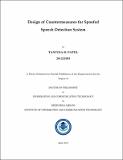Design of countermeasures for spoofed speech detection system
Abstract
Automatic Speaker Verification (ASV) systems are vulnerable to speech synthesisand voice conversion techniques due to spoofing attacks.Recently, to encourage thedevelopment of anti-spoofing measures or countermeasures for Spoofed Speech Detection (SSD) task, a standardized dataset was provided at the 'ASV spoof 2015 challenge' held at INTERSPEECH 2015. In the present work, using a traditional Gaussian Mixture Model (GMM)-based classification system, novel countermeasures are proposed considering three vital aspects of speech production mechanism, i.e., excitation source, vocal tract system (i.e., filter) and Source-Filter (S-F) interaction.
Considering our relatively best performance at the ASV spoof challenge, we first discuss system-based features that include proposed Cochlear Filter Cepstral Coefficients and Instantaneous Frequency (CFCCIF) features. These use the envelope and average IF of each subband along with the transient information. The transient variations estimated by the symmetric difference (CFCCIFS) gave better discrimination. Within the framework of system-based features, the Subband Autoencoder (SBAE) feature set that embeds subband processing in the Autoencoder architecture is used. For source-based features, knowing that an actual vocal fold movement is absent in machine-generated speech, fundamental frequency (F0) contour and Strength of Excitation (SoE) are used as features. Next, as spoofed speech is easily predicted if generated by a simplified model or difficult to predict due to artifacts, we propose the use of prediction-based methods. This includes the Linear Prediction (LP), Long-Term Prediction (LTP) and Non-Linear Prediction (NLP) techniques. Lastly, the Fujisaki Model is used to analyze the prosodic differences in terms of accent and phrase between natural and spoofed speech. In addition to independently using source or system features, the time-varying dependencies or the S-F interaction features are considered. This includes exploring Features based on the residual information of the glottal excitation source and its fitted Liljencrants-Fant (LF) model, both in time-domain and frequency-domain for the SSD task.
Collections
- PhD Theses [87]

